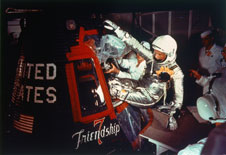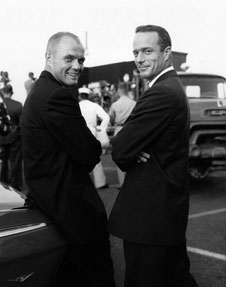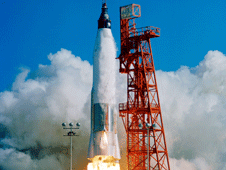From NASA- The Beatles were eight months away from releasing their first single, "Love Me Do," when John Glenn rocketed into space on Feb. 20, 1962, to become the first American to orbit Earth.
The flight set NASA on course to meet ever-more ambitious goals. Glenn's three orbits in five hours was eclipsed on the next flight and each one afterward steadily pushed Americans further out from the cradle of Earth, ultimately leading to a series of landings on the moon from 1969 to 1972.

John Glenn climbs inside the Mercury capsule he dubbed "Friendship 7" on Feb. 20, 1962, before launching into space. Photo credit: NASA
"The whole program shifted rapidly from, 'Can we do this?' to basic research," Glenn told a packed press conference conducted among the displays and consoles that made up Cape Canaveral's Mercury control center.
Fifty years after the Mercury-Atlas 6 mission, Glenn, 90, still draws a capacity crowd. He returned to NASA's Kennedy Space Center in Florida on Friday to begin a weekend of events celebrating the milestone.
The events come a few days before the 50th anniversary, but that did not diminish the excitement of those on hand to see Glenn. Fellow Mercury astronaut Scott Carpenter, who served as CapCom during Glenn's mission before flying his own mission three months later, also made the trip to Florida to celebrate NASA's first orbital missions.

Mercury astronauts John Glenn, left, and Scott Carpenter were two of NASA's original seven astronauts. Photo credit: NASA
"It was not a solo effort," Carpenter said. "It took thousands of people to get him safely up there and back." At that point, two American astronauts made short trips into space, but did not reach orbit. They flew on the Redstone, a rocket that was extremely reliable, but not strong enough to send a person into orbit.
The flight also changed Glenn's course. A record-setting test pilot before he became one of America's original astronauts, Glenn left NASA soon after the Mercury mission and entered the political world. He would serve in the United State Senate from his home state of Ohio and make a run for the White House.

The Atlas rocket carrying John Glenn and his Mercury capsule lift off Feb. 20, 1962, from Launch Complex 14 at Cape Canaveral Air Force Station. Photo credit: NASA
While it seemed for decades that Glenn's space experience was limited to those three orbits in 1962, the astronaut was enlisted to fly again in 1998, this time aboard space shuttle Discovery. While the Mercury capsule was snug with just one person inside, the shuttle was comfortable with seven people inside. Glenn, then 77, conducted numerous experiments to see how his body had changed since his first mission.
Now retired from space and politics, Glenn said the challenge of spaceflight continues to press today's designers and engineers to keep making strides.
"These things depend on people," Glenn said. "Nothing's going to happen unless you have people to do it."
-Steven Siceloff, NASA's Kennedy Space Center , FMI: entire NASA article